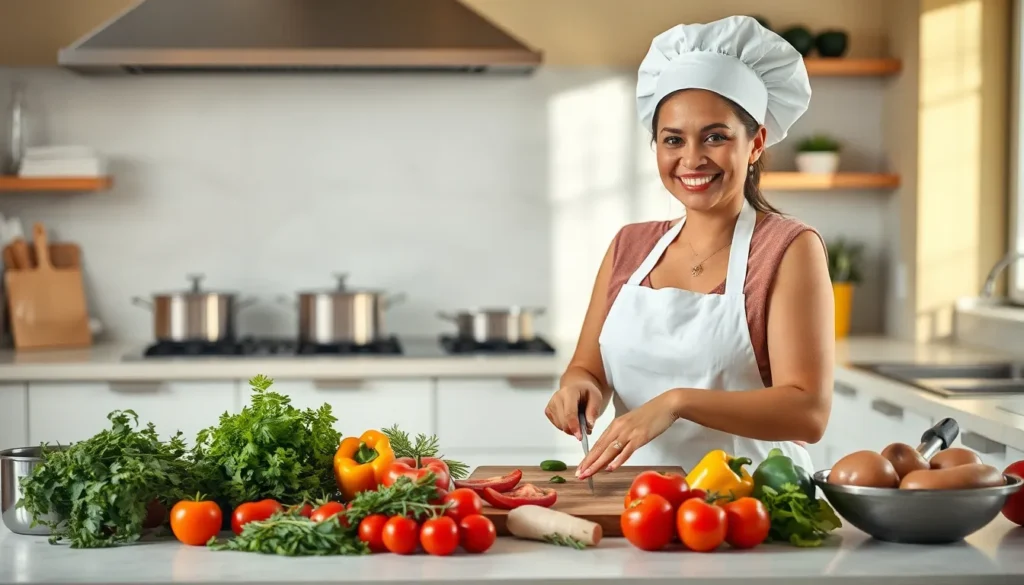Cooking isn’t just about throwing ingredients together; it’s an art form that can transform a mundane meal into a culinary masterpiece. Whether you’re a kitchen novice or a self-proclaimed chef, mastering the basics of cooking can feel like unlocking a secret door to a world of delicious possibilities. Imagine impressing friends with your signature dish or finally perfecting Grandma’s secret recipe.
Table of Contents
ToggleUnderstanding Cooking Techniques
Cooking encompasses a variety of methods that transform raw ingredients into delicious meals. Mastering these techniques enhances culinary skills and boosts confidence in the kitchen.
Basic Cooking Methods
Boiling involves cooking food in water at high temperatures, making it suitable for pasta and vegetables. Steaming utilizes water vapor to preserve nutrients in foods like fish and greens. Sautéing requires minimal oil over direct heat, perfect for quick-cooking highlight flavors. Baking cooks food evenly in an oven, ideal for bread and casseroles. Roasting exposes food to dry heat, producing a crispy exterior, especially for meats and root vegetables. Grilling applies direct heat from below, adding a smoky flavor to meats and vegetables.
Advanced Cooking Techniques
Sous vide allows precision cooking in vacuum-sealed bags immersed in water, resulting in consistent textures. Braising combines both wet and dry heat, tenderizing tough cuts of meat over long periods. Fermenting encourages beneficial bacteria growth, enhancing flavors in products like yogurt and kimchi. Emulsifying creates stable mixtures, often used in dressings and sauces, bringing ingredients together seamlessly. Foaming introduces air into liquids, creating light, airy textures for sauces and desserts. Smoking imparts rich flavors using wood or charcoal, transforming meats and vegetables with unique aromas.
Essential Cooking Tools

Cooking effectively requires the right tools. Essential equipment enhances every culinary task, making the kitchen experience enjoyable and efficient.
Must-Have Kitchen Equipment
Chef’s knives, cutting boards, and pots are foundational in any kitchen. A sturdy chef’s knife excels at chopping and dicing, ensuring precision. Quality cutting boards protect counters while providing a stable surface for food prep. Essential pots come in various sizes, catering to everything from sauces to soups to stews. Other necessities include measuring cups and spoons, which guarantee accurate ingredient portions. Lastly, a reliable frying pan enables versatile cooking methods from frying to sautéing.
Useful Gadgets for Home Cooks
Numerous gadgets simplify kitchen tasks for home cooks. A food processor speeds up slicing and shredding, saving significant prep time. Another handy tool is an immersion blender, perfect for pureeing soups directly in their pots. Silicone spatulas ease mixing without scratching cookware. A digital kitchen scale accurately measures ingredients, ensuring consistency in recipes. Instant-read thermometers provide precise cooking temperatures, promoting food safety and ideal doneness. Lastly, a multi-functional peeler combines multiple functions, reducing clutter in drawers.
Ingredients and Flavoring
Selecting quality ingredients plays a crucial role in cooking delicious meals. Fresh produce enhances flavor and nutritional value. Look for colorful vegetables and firm fruits, indicating ripeness. Choose meats that have a vibrant color and no unpleasant odor to ensure freshness. Seasonal ingredients often taste better and provide more nutrients.
Selecting Fresh Ingredients
Inspecting ingredients carefully leads to better cooking outcomes. He or she should prioritize organic options when possible, as these typically lack chemical pesticides. When buying produce, avoid items with bruises or discoloration. Fresh herbs deliver intense flavor; cilantro, basil, and parsley stand out as favorites for many dishes. Meat, poultry, and seafood require a careful selection process; check for proper packaging and appropriate expiration dates. Visiting local farmers’ markets can yield the best seasonal ingredients.
Common Spices and Seasonings
Utilizing a variety of spices and seasonings transforms dishes significantly. Salt serves as a foundational seasoning, enhancing natural flavors. Black pepper adds a subtle heat that elevates meals. Garlic powder and onion powder provide depth and aroma, making cooking more enjoyable. Other essential spices include cumin, paprika, and oregano, which add complexity to various cuisines. Exploring international spice blends, like curry powder or za’atar, introduces unique flavors. Each spice possesses its own unique profile, enhancing a dish’s overall appeal and character.
Steps to Follow When Cooking
Following specific steps can enhance the cooking process. Each stage contributes to creating delicious meals.
Preparing Ingredients
Choosing quality ingredients sets the foundation for a great dish. Wash and chop vegetables, ensuring uniform sizes for even cooking. Measure out spices and seasonings before starting; organizing these items promotes efficiency. Cutting fruits into appropriate sizes helps to balance flavors. Additionally, marinating meats ahead of time infuses flavors, enhancing the overall taste. Ensure all equipment is ready and within reach to streamline the cooking process.
Cooking and Serving Tips
Utilizing different cooking techniques can elevate any dish. Sauté vegetables over medium heat to caramelize their natural sugars. For proteins, using a meat thermometer ensures proper cooking temperatures, avoiding foodborne illnesses. Experiment with seasoning throughout the cooking process for depth of flavor. Once plated, garnish dishes with fresh herbs or a drizzle of sauce to enhance presentation. Serving meals immediately after cooking retains optimal texture and flavor. Sharing meals directly from the stovetop creates an inviting atmosphere, encouraging enjoyment among diners.
Conclusion
Cooking is a rewarding journey that combines creativity with skill. By embracing essential techniques and investing in quality tools, anyone can elevate their culinary game. The joy of preparing meals not only lies in the process but also in the shared experiences around the dining table.
Selecting fresh ingredients and experimenting with flavors can transform everyday cooking into an exciting adventure. As confidence grows in the kitchen, so does the ability to explore new recipes and techniques. This ongoing journey not only nurtures the palate but also fosters a deeper appreciation for the art of cooking. With each dish prepared, the possibilities are endless.





